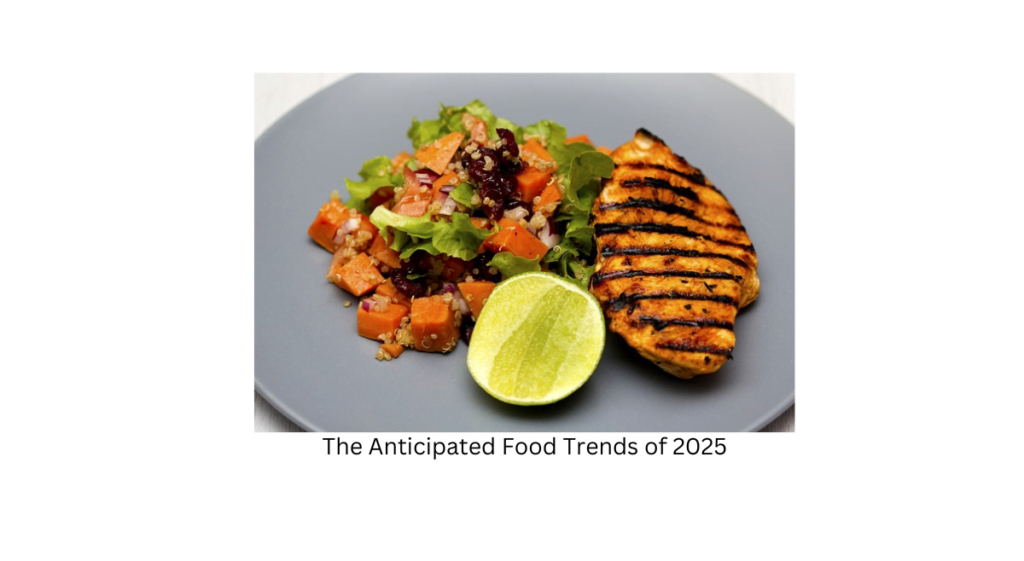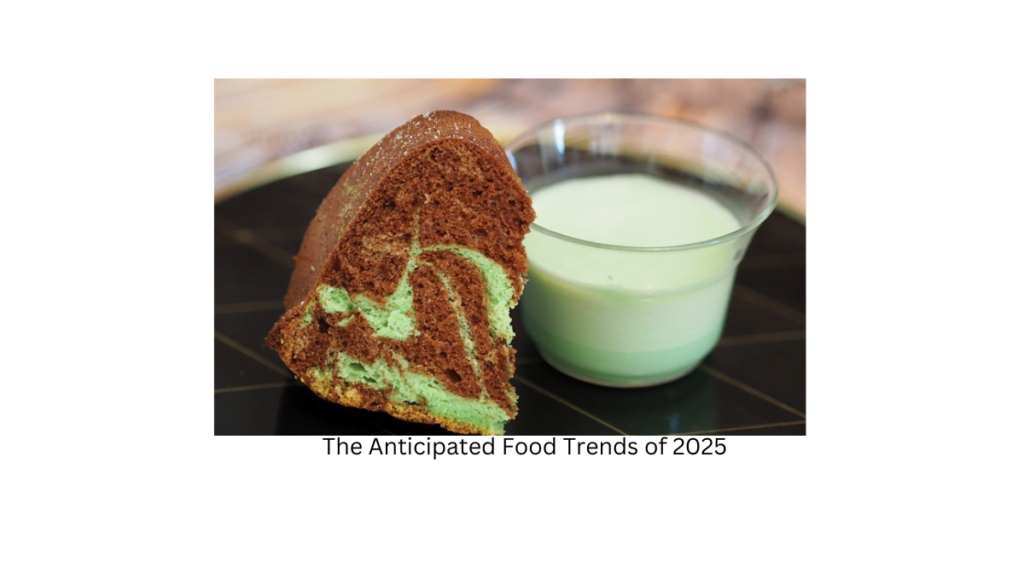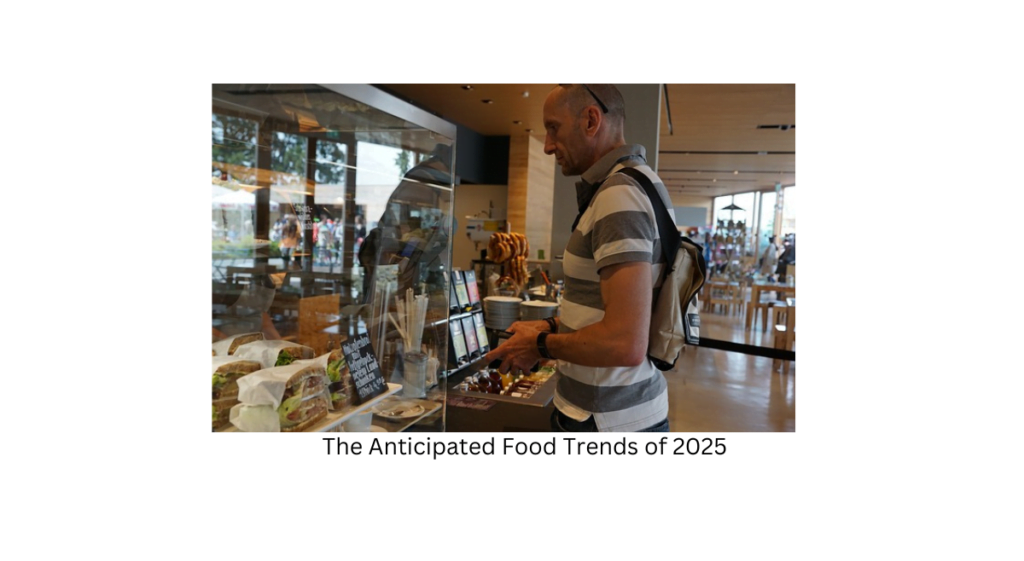Introduction:-
Unveiling the Anticipated Food Trends of 2025: What’s Next on the Culinary Horizon?

As we approach 2025, the culinary world is abuzz with anticipation about the next big food trends that will shape our dining experiences in the coming years. Food has always been a reflection of culture, technology, and changing consumer preferences. So, what can we expect to see on our plates in 2025? Let’s dive into the exciting world of food trends of 2025 and explore what’s on the culinary horizon.
What adverse impact will Food Trends of 2025 have on our lives?
While food trends in 2025 are expected to bring about numerous positive changes in the way we eat, cook, and think about food, they may also have some adverse impacts on our lives. Here are some potential negative consequences and challenges associated with these trends:

- Environmental Concerns: Some food trends, such as the increased demand for exotic ingredients or out-of-season produce, can contribute to higher carbon footprints due to long-distance transportation. This may exacerbate climate change and environmental degradation.
- Health Challenges: While there is a growing focus on health and wellness, certain food trends may lead to dietary imbalances if not followed mindfully. For example, an overreliance on processed plant-based foods or trendy diets without proper nutritional guidance can lead to health issues.
- Economic Disparities: The emphasis on organic, local, and sustainably sourced foods may result in higher prices for these products. This could exacerbate economic disparities, making healthier and more sustainable food options inaccessible to lower-income populations.
- Food Safety Concerns: As food technology advances, there may be concerns about the safety of genetically modified organisms (GMOs), lab-grown meats, or novel food production methods. Ensuring the safety of these innovations will be crucial.
- Cultural Appropriation: While fusion cuisine can be exciting and creative, there may be instances of cultural appropriation where traditional dishes are adapted without proper acknowledgment or respect for their cultural origins.
- Overreliance on Technology: The integration of technology into the dining experience can lead to concerns about privacy, data security, and the loss of authentic human interactions in restaurant settings.
- Waste and Packaging: Despite efforts to reduce food waste, the increased popularity of takeout and food delivery, often associated with single-use packaging, can contribute to more waste in landfills.
- Loss of Culinary Diversity: The globalization of food trends and the rise of fusion cuisine may lead to a homogenization of culinary offerings, potentially diminishing the diversity of traditional and regional dishes.
- Economic Impact on Traditional Food Producers: As consumer preferences shift towards new food trends, traditional food producers who rely on age-old practices may struggle to adapt and face economic challenges.
- Consumer Confusion: The rapid proliferation of food trends and dietary advice can sometimes confuse consumers. It may be challenging to discern between genuinely healthful choices and marketing-driven fads.
- Social Media Pressure: The influence of social media on food trends can create unrealistic expectations and lead to social pressure to conform to specific diets or lifestyles.
- Dependency on Big Tech: The integration of AI and technology into food production and delivery systems may lead to increased dependency on large tech companies, potentially reducing market competition and innovation.
It’s important to note that these adverse impacts can often be mitigated with conscious consumer choices, responsible industry practices, and appropriate government regulations. Additionally, many of these challenges are not unique to food trends in 2025 but are ongoing issues in the food industry that require ongoing attention and solutions. It’s essential for individuals, businesses, and policymakers to work together to ensure that the positive aspects of food trends are maximized while addressing and mitigating their potential negative consequences.
As we dive into the dynamic world food trends of 2025 for the upcoming year, what exciting culinary trends can we expect to grace our plates in 2025?
1. Plant-Based Everything
The rise of plant-based eating has been one of the most significant food trends of the past decade, and it shows no sign of slowing down in 2025. From plant-based meat alternatives to dairy-free cheeses and egg substitutes, consumers are increasingly looking for delicious and sustainable options that align with their values. Expect to see more innovative plant-based products and menu items that cater to a growing audience of flexitarians,vegetarians, and vegans.

2. Hyper-Local Ingredients
The locavore movement, which emphasizes sourcing ingredients locally, is gaining momentum. In 2025, we’ll see chefs and home cooks alike placing a premium on hyper-local ingredients. This trend not only supports local farmers and reduces carbon footprints but also allows for a deeper connection between food and its place of origin. Farmers’ markets and community-supported agriculture (CSA) programs will continue to thrive, connecting consumers directly with local growers.
3. Global Fusion Cuisine
In a world where borders are becoming less defined, culinary boundaries are also dissolving. Fusion cuisine will take center stage in 2025, blending flavors and techniques from different parts of the world to create exciting and unique dishes. Whether it’s Korean tacos, Indian-inspired pizzas, or Japanese-Peruvian ceviche, expect your taste buds to embark on a global culinary adventure.
4. Smart and Sustainable Dining
Sustainability is no longer a niche concern but a mainstream priority. In 2025, we’ll witness a surge in smart and sustainable dining practices. Restaurants will adopt more eco-friendly practices, such as reducing food waste, using renewable energy sources, and implementing carbon-neutral initiatives. Additionally, diners will become more conscious of their food choices, opting for restaurants that prioritize sustainability in their operations.
5. Tech-Enhanced Dining Experiences
Technology will continue to shape how we dine in 2025. From digital menus and contactless payments to augmented reality (AR) dining experiences, technology will play a significant role in enhancing the way we interact with food. Expect to see more immersive dining experiences that blend the physical and digital realms, making meals not just delicious but also visually stunning and entertaining.
6. Health and Wellness-Centric Menus
The global focus on health and wellness will influence food trends in 2025. Menus will increasingly feature items that promote physical and mental well-being. This includes nutrient-dense superfoods, gut-healthy probiotics, and dishes designed to boost immunity. Restaurants and food companies will also provide clearer nutritional information, catering to health-conscious consumers.
7. DIY Dining Kits
The pandemic accelerated the trend of DIY dining, where restaurants and food companies offer meal kits for customers to prepare at home. In 2025, we can expect this trend to evolve further, with more diverse and customizable options. These kits will not only cater to those seeking convenience but also those looking to hone their culinary skills and experiment with new flavors.
8. Personalized Nutrition
Advancements in technology and nutrition science will allow for more personalized dining experiences in 2025. From DNA-based diets to AI-powered meal recommendations, individuals will have access to tailored nutrition plans that cater to their specific dietary needs and preferences. This level of personalization will redefine the way we approach food and wellness.
9. Rediscovering Traditional and Heritage Foods
Amidst all the innovation, there will be a resurgence of interest in traditional and heritage foods in 2025. Consumers will seek out authentic and time-tested recipes passed down through generations. This trend not only celebrates cultural diversity but also preserves culinary traditions that might otherwise fade away.
10. Ethical and Transparent Sourcing
Consumers are becoming increasingly concerned about the ethical and transparent sourcing of ingredients. In 2025, food companies and restaurants will need to be more forthcoming about the origins of their products and their treatment of workers and animals. Ethical sourcing and fair labor practices will be a selling point for businesses that want to win over conscientious consumers.
In conclusion,
2025 promises to be an exciting year for food enthusiasts and industry professionals alike. With a strong focus on sustainability, technology, and culinary creativity, the food trends of 2025 are poised to transform the way we eat, cook, and think about food. Whether you’re a committed foodie or just someone who enjoys a good meal, get ready to embark on a culinary journey filled with flavors, innovation, and delicious surprises.





